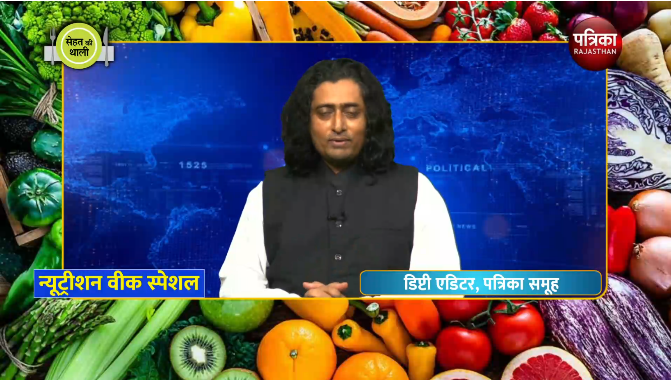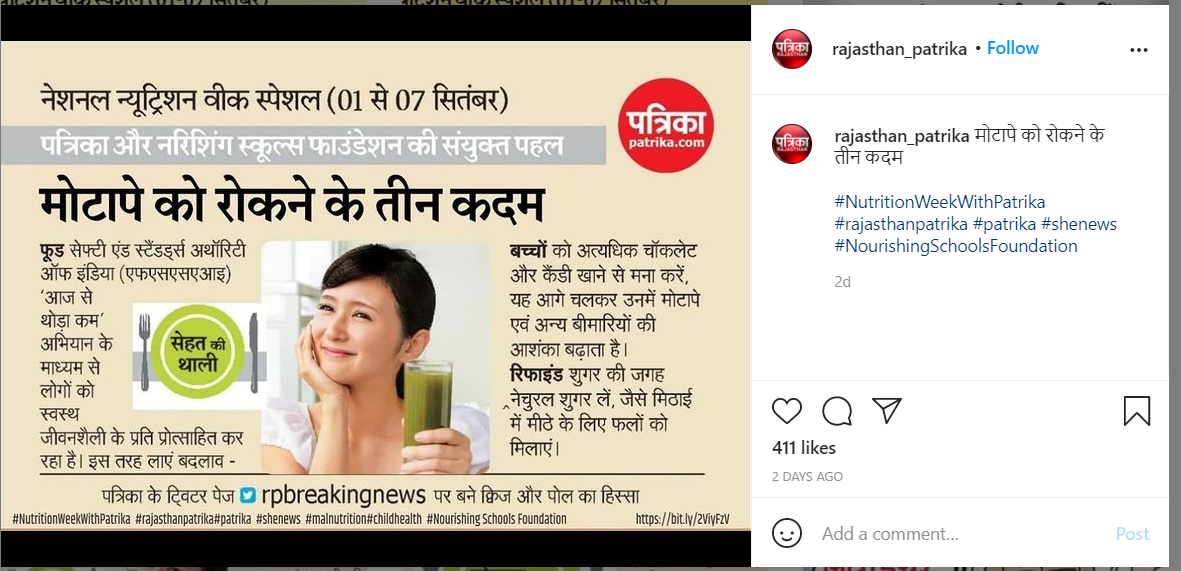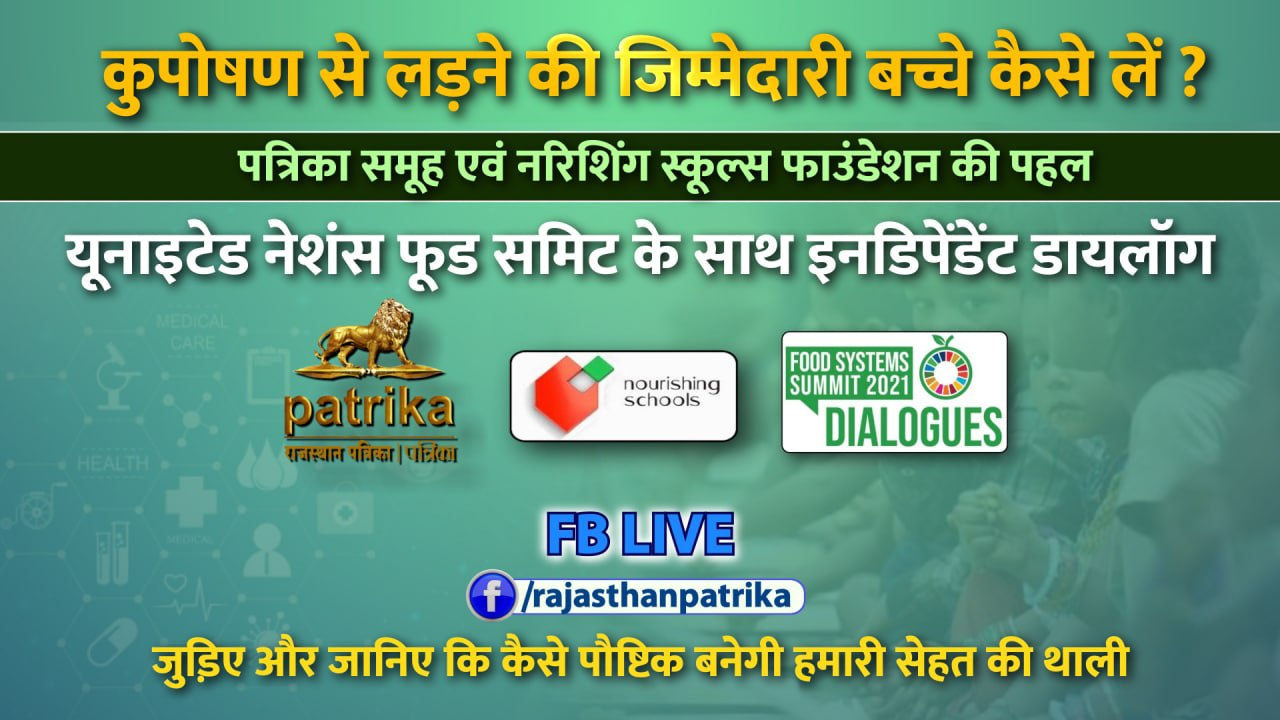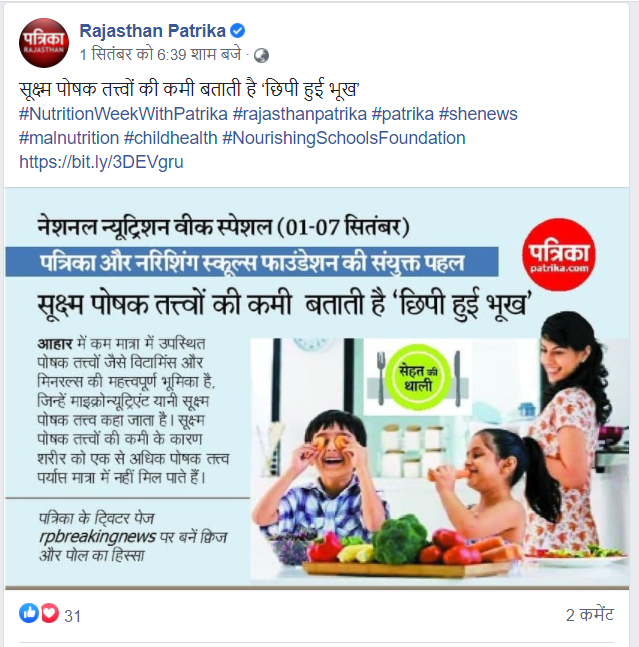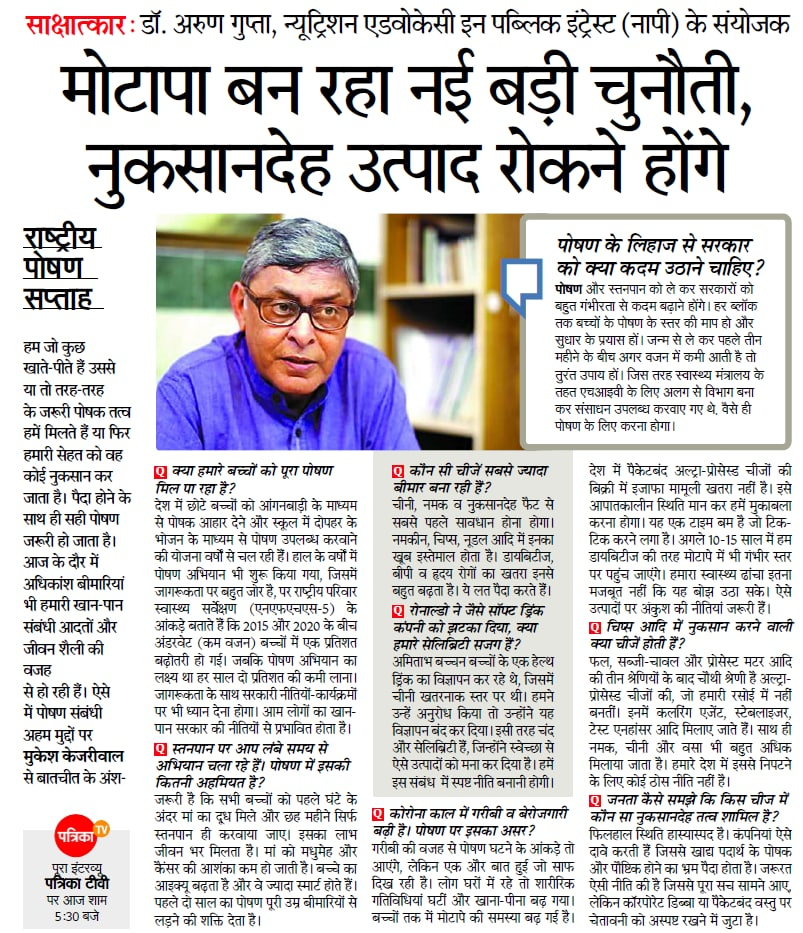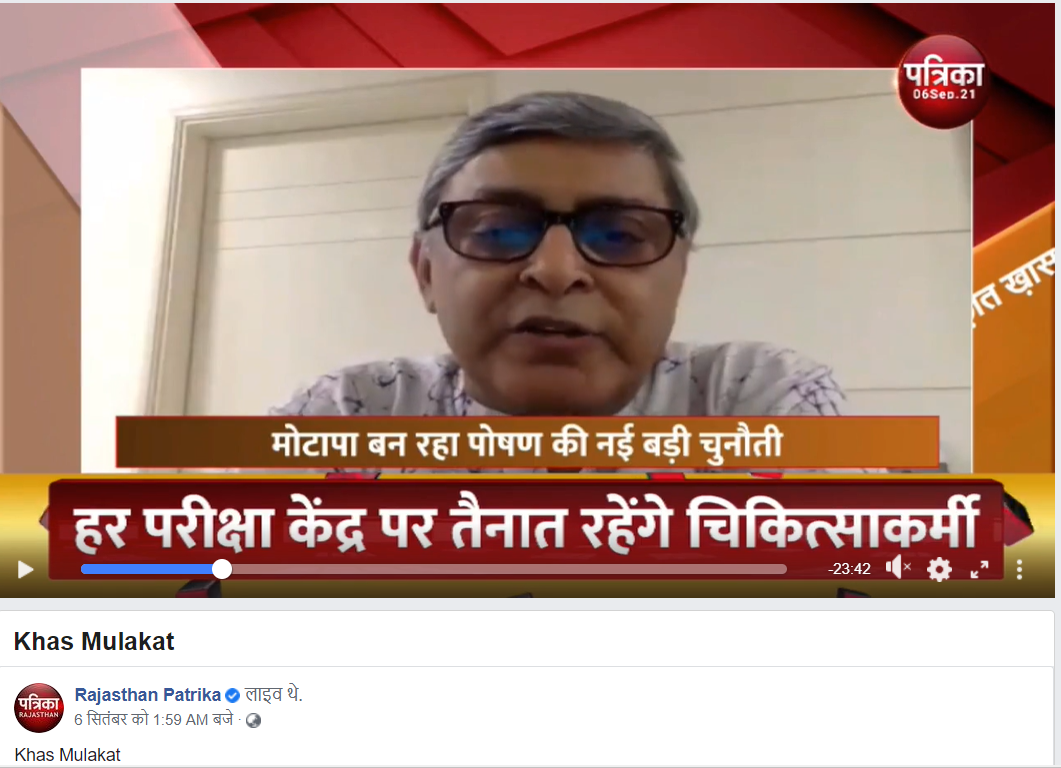- Welcome to Patrika Foundation
- +91 89054 44474
- info.patrikafoundation@in.patrika.com
National Nutrition Month
National Nutrition Month is an annual nutrition event initiated by the Food and Nutrition Board, Ministry of Women and Child Development, Government of India. It is observed throughout the country from 1st to 7th September every year.
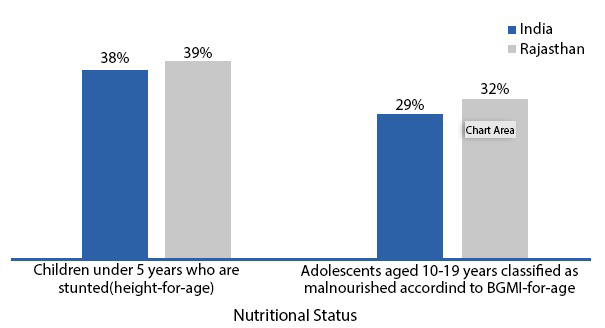
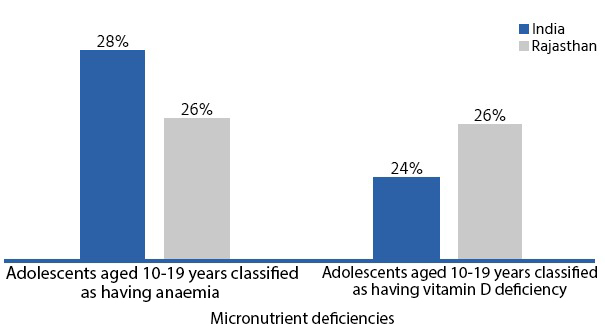
Sources : International Institute for Population Sciences (IIPS) and ICF. 2017. National Family Health Survey (NFHS-4), 2015-16: India); Ministry of Health and Family Welfare, Government of India, UNICEF and Population Council. 2019. Comprehensive National Nutrition Survey
Nutrition is a complex challenge in India as evident from the data regarding this topic
38.4% of children under 5 years in India are chronically undernourished (stunted). Stunting in children is often linked to malnutrition in adolescence for their parents, especially for girls. 28.9% of adolescents aged 10–19 years are classified as malnourished according to BMI-for-age in India. 32.2% of adolescents aged 10–19 years are classified as malnourished according to BMI-for-age in Rajasthan.
Malnourishment stems from a lack of awareness regarding nutrition as well as a lack of access to solutions to improve one’s nutritional status. To help tackle these issues, the Patrika Group and Nourishing Schools Foundation partnered on a National Nutrition Week campaign in 2021.
The campaign explained nutrition-related data, concepts like adolescent nutrition, hidden hunger, metrics for measuring nutritional status etc. in an easy-to-understand manner, conducted polls to understand behaviours and encouraged Patrika’s audience to take charge of tackling malnutrition
This collaboration was envisioned as a first step to engaging various stakeholders in tackling malnutrition, such as the government, civil society organisations, corporates, media, schools, parents and children. It sought to highlight the systemic issues causing malnutrition as well as a few solutions to address these challenges. By combining fact-based information with insights from data and experts in engaging formats, the campaign helped demystify nutrition and highlighted ways for stakeholders to tackle malnutrition.
Theme 1: Explaining Nutrition- What is a balanced diet?
A balanced diet contains different types of foods in appropriate quantities and proportions in such a way that the need for all the nutrients such as carbohydrates, proteins, fats, vitamins, minerals, water and fibre are adequately met. In addition, a balanced diet also provides an extra allowance of nutrients to be stored in our body, which can be used in conditions of stress, like illness, injury, etc. Consuming a balanced diet helps prevent malnutrition. Promoting a balanced diet was a part of the Eat Right India movement launched by the Food Safety and Standards Authority of India with the tagline ‘Sahi Bhojan. Behtar Jeevan’.
Theme 2: Types of Nutritional Deficiencies
A nutritional deficiency is when your body does not get enough of one of more nutrients. This can be due to lack of macronutrients, which are required by the body in larger quantities such as carbohydrate, fat and protein. More often, this is due to the lack of micronutrients i.e., vitamins and minerals that are needed by our body only in minuscule amounts. The effects of these micronutrient deficiencies are also known as ‘hidden hunger’. These micronutrients are essential for sustained growth and development, fighting infections, building immunity and that’s why the consequences of their deficiency can be severe.
Theme 3: Infant Nutrition, New-born Health, Breastfeeding
Infant and Young Child Feeding (IYCF) refers to a set of well-known and recommended appropriate feeding practices for new-born and children up to two years of age. These practices have various benefits. Early initiation of breastfeeding, within 1 hour of birth, protects the new born from acquiring infections and reduces new born mortality. Breastfeeding also has a positive impact on cognitive development. Complementary Feeding promotes optimal growth, prevents stunting, micronutrient deficiencies, prevalence of anaemia and being overweight. Optimal IYCF Practices (box inset) Initial Breastfeeding: Early initiation of breastfeeding; immediately after birth, preferably within one-hour Exclusive Breastfeeding: Exclusive breastfeeding for the first six months of life Complementary Feeding: Timely introduction of complementary food (maintaining adequate diet and dietary diversity) beyond six months along with continued breastfeeding Source: Ministry of Health and Family Welfare, Government of India.
Theme 4: Child Growth, Child Health, Adolescent Nutrition
Adolescence is a time of rapid physical, cognitive and psychosocial growth. During this time, adolescents form long-term habits related to their diet and physical activity - which has an impact on their health over their lifetime. Due to this, chronic malnourishment of children under 5 years is often linked to malnourishment in their parents during adolescence, especially mothers. It is therefore critical that adolescents learn healthy habits during this time period, that set help them improve their own and their communities’ nutrition. Adolescents and Physical Activity (Box inset) WHO recommends for adolescents to accumulate at least 60 minutes of moderate- to vigorous intensity physical activity daily, which may include play, games, sports, but also activity for transportation (such as cycling and walking), or physical education. Globally, only 1 in 5 adolescents are estimated to meet these guidelines.
Theme 5: Water, Hygiene, Sanitation, Nutrition
Drinking unclean water, following poor personal hygiene and using inadequate sanitation facilities can increase the risk of illnesses such as diarrhoea. Those who are malnourished are more vulnerable to diarrhoea and each diarrhoea episode can worsen malnutrition. This creates a vicious cycle. Diarrhoea is a leading cause of malnutrition in children under five years old. Therefore, safe drinking water, sanitation and hygiene are essential for being healthy and well-nourished. According to WHO, Better water, sanitation, and hygiene could prevent the deaths of 297,000 children aged Water, Hygiene, Sanitation and Nutrition under 5 years each year globally.
Benefits of improving sanitation (box inset) In addition to reducing the risk of diarrhoea, improving sanitation has many benefits such as:
- Reducing the spread of intestinal worms
- Reducing the severity and impact of malnutrition
- Promoting school attendance. Girls’ school attendance is particularly boosted by the provision of separate sanitary facilities
Theme 6: Obesity
Overweight and obesity are defined as abnormal or excessive fat accumulation that presents a risk to health. This usually occurs when we take in more calories than we are burning through exercise and normal daily activities. The prevalence of people being overweight or obese has been increasing in India over the past several years. Obesity is one aspect of being malnourished (the other is being undernourished). With changes in one’s diet and lifestyle, it is possible to prevent and manage obesity.
Harmful effects of obesity (box inset) Compared to those who have a healthy weight, people who are obese are at increased risk of various illnesses and conditions such as
- High blood pressure (Hypertension)
- High LDL cholesterol, low HDL cholesterol, or high levels of triglycerides
- Type 2 diabetes
- Coronary heart disease
- Stroke
- Gallbladder disease
- Insomnia and breathing problems
- Mental illness such as clinical depression, anxiety, and other mental disorders
Theme 7: Agriculture, Seasonal and Regional Eating
Agriculture patterns affect the access to adequate and affordable nutritious foods. The Green Revolution led to a focus on growing wheat and rice in India. As a result of this, the consumption of other cereals such as millets reduced from people’s diets as their supply reduced. Experts have recently been pointing out the health benefits of millets and their consumption has started to increase gradually. In 2019, the Ministry of Human Resource Development issued guidelines for developing and maintaining nutrition gardens in all schools, both in urban and rural areas. The objectives of this were to help children get access to nutritious foods to prevent malnutrition, to help children learn how to grow their own food and to help them learn about the nutritional aspects of foods such as vegetables.
Independent Dialogues under UN Food Systems Summit
Dialogue 1:
Malnourishment stems from a lack of awareness regarding nutrition as well as a lack of access to solutions to improve one’s nutritional status. To help tackle this, it is essential to help children learn about their malnutrition and how to tackle it, in their pre-adolescent and adolescent years. These years offer a key window for shaping lifetime habits and developing children into agents of change.
As a part of National Nutrition Month or Poshan Maah in India, this dialogue convened experts from various fields to discuss the following issues:
- Scope of the malnutrition challenge in India
- Steps that children can take to tackle this challenge
- Barriers that hinder children from taking action and how to address them
- Examples/stories of children who have helped tackle malnutrition in their communities
Dialogue 2:
Drinking unclean water, following poor personal hygiene, and using inadequate sanitation facilities can increase the risk of illnesses such as diarrhoea. Those who are malnourished are more vulnerable to diarrhoea and each diarrhoea episode can worsen malnutrition. This creates a vicious cycle. Diarrhoea is a leading cause of malnutrition in children under five years old. Therefore, safe drinking water, sanitation and hygiene are essential for being healthy and well-nourished. According to WHO, Better water, sanitation, and hygiene could prevent the deaths of 297,000 children aged under 5 years each year globally.
The causes of poor water, sanitation and hygiene are two-fold: lack of access to adequate infrastructure and lack of behaviour change to adopt the use of proper infrastructure and practices. As a part of National Nutrition Month or Poshan Maah in India, this dialogue will convene experts from various fields to discuss the following issues:
- The link between water, sanitation and hygiene (WASH) and nutrition
- How we can improve the access to amenities for safe drinking water, proper sanitation and hygiene
- How we can change behaviours related to water, sanitation and hygiene
- Challenges that still needs to be addressed on this topic.
Gallery


